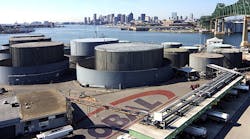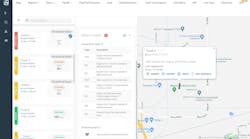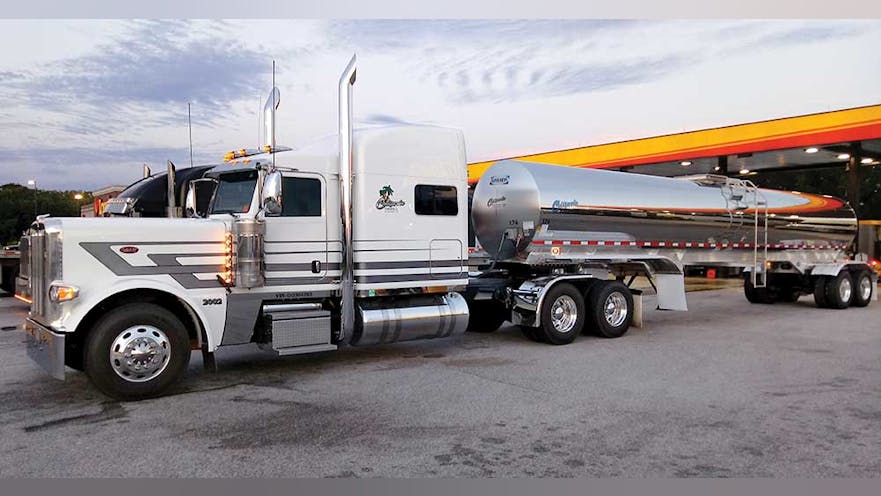A FAMILY-owned trucking company specializing in food and edibles freight, California Overland Ltd has established a solid position in the industry. The carrier’s ability to handle critical and difficult shipments has brought steady success.
Based in Wabasha, Minnesota, on the banks of the Mississippi River, California Overland has grown from a single truck to a fleet of 145 tractors, 20 sanitary tank trailers, and 250 refrigerated trailers.
The fleet runs as an irregular-route carrier throughout the 48 contiguous US states and in the Canadian provinces of Ontario and Quebec. Tank truck operators are concentrated in the eastern half of the United States.
Russ Meyer, chief executive officer of California Overland, started the carrier in 2001 after taking a break from trucking for several years in the late 1990s. This is the second refrigerated/tank truck fleet he and his family built from scratch.
“Trucking—especially food hauling—was in my blood, and it didn’t take long to realize I wanted to get back in,” Meyer says. “One of the benefits of starting over is that you know what not to do. You have a better idea how to avoid mistakes. This is a better trucking company than the first one we built.
“California Overland has grown steadily. By 2002, we had 10 tractors on the road, and we had expanded into foodgrade dry bulk hauling with about seven dry bulk trailers. With our first fleet, we also ran a mix of reefers and tanks.
“We were up to 10 refrigerated trailers toward the end of 2004,, and our refrigerated operations have continued to grow. We sold off the bulkers in 2006, but we began adding sanitary tank trailers in 2008. The tanks are used to transport pet food ingredients.
“We named our company California Overland, because we do a lot of business with customers in that state. We have had a big presence in California for many years. Still, we are a Minnesota company.
“Our basic philosophy at California Overland is to instill pride in our drivers and support personnel. We buy late model, state of the art equipment, and maintain it meticulously. We keep our equipment clean and free from all damage. Our drivers are proud to drive for us and, in turn, they are safer, customer orientated, courteous and respectful on the highway. A proud driver is the secret to a professional transportation company’s success because he takes care of his rig, delivers on time, and is involved in less accident situations.”
Growing operation
Initially based in Theilman, the carrier moved to Lake City in 2005. More recently California Overland opened the 10-acre Wabasha headquarters and terminal. Meyer says the location offers ample opportunity for expansion and diversification.
A main building contains offices, a six-bay maintenance shop, and a cleaning rack for washing tractors and trailers. A large log cabin that would look at home in the back woods serves as a driver lounge and training center. The Northwoods Lounge is located next to the operations building and is accessible to drivers 24 hours a day.
“We wanted to provide comfort and personal convenience for our drivers while they are away from home.” Meyer says. “Opened this year, the lounge has multiple showers, bathrooms, washers and dryers at no charge, and a kitchen, along with a family room area with computers, WIFI, and a huge 65” television. It’s our way of showing our appreciation and thanking our drivers for all they do on a daily basis.”
Three divisions
Operations are divided into three divisions: Truckload carrier, intermodal, and brokerage. On the truckload carrier side, California Overland offers standard and expedited freight options. Typical hauls are from a food shipper to a grocery distribution center. Drivers just drive, and the company keeps them moving. In total, the fleet runs roughly 15.5 million miles a year providing a mix of longhaul and regional service.
The intermodal division provides the convenience of door-to-door service with the reliability of trailer-on-flatcar transport. All of the refrigerated trailers in the fleet are configured for TOFC service. The operation handles dry or temperature controlled goods and operates throughout the lower 48.
The brokerage, California Solutions Ltd, offers more transport options for a shipper. “We utilize our relationships with other carriers and our experience to obtain competitive rates, without the risk of jeopardizing quality service,” Meyer says. “We manage each shipment through from start to finish with 24-hr tracking, and a member of our team assigned directly to each customer.”
McLeod dispatch software is used through all of the California Overland divisions. All operations are managed through the central dispatch at the Wabasha office.
Dispersed fleet
While management is centrally located, the California Overland fleet is dispersed across the United States. “Our drivers live all over the country,” says Dusty Meyer, president of California Overland.
Drivers run singles in the tank operation. Typical tanker trips are two to three days out and back, with limited back hauls.
California Overland works hard to keep drivers happy, and a turnover rate of just 18% indicates that the carrier is moving in the right direction. The carrier does its best to make the job comfortable.
Good driver retention is critical today, according to Dusty Meyer. “There is a lot of competition for the good drivers who are out there,” he says. “Referrals from our employees produce some of the best recruiting results, but we also use social media and marketing to reach potential candidates.
“Good drivers aren’t the only workers in short supply, though. The help wanted sign is out every day at every trucking company. We need dispatchers, diesel technicians, and other critical support staff. And we need to be able to recruit younger people.”
Family focus
On the driver side, Gregg Moyer, California Overland safety director, says: “We’re definitely seeing drivers stay with us longer. We offer good pay and good benefits. We pay above the industry average for new hires.
We treat them with respect, and we offer a family atmosphere that includes a relatively liberal policy on passengers. We provide company drivers with late model tractors, and all of the equipment in our fleet is very well maintained.”
When it comes to passengers in the tractor, the carrier allows drivers to be accompanied by immediate family, such as spouse or children. Drivers must have a passenger insurance policy.
The carrier is very active with social media. For instance, drivers are encouraged to submit photos of photos taken on the road. The best ones on posted as “The Photo of the Week” on Facebook.
Three years ago, the carrier launched a 10-year service award to recognize its best and most loyal drivers. “We focus on years, rather than miles, because some of our drivers are not running in the high-mileage side of our operation,” Moyer says. “We’ve recognized better than dozen drivers so far.”
Driver requirements
Basic requirements to drive for California Overland include a valid commercial driver license, at least two years of over-the-road tractor-trailer experience, a working knowledge of applicable Department of Transportation regulations, ability to meet the medical standards set by DOT and pass a DOT drug screen, and no serious traffic violations in the past three years. Drivers are encouraged to obtain a tank endorsement, and about 25% of the driver force has done so.
Those hired go through a 1.5-day orientation at the terminal facility in Wabasha. That is just the beginning of the training process.
“We require constant training at California Overland, Moyer says. “We use online-based training from Vertical Alliance, because drivers can access required instruction modules during breaks while they are on the road. We track and record all training.”
Safety is a critical focus for the fleet, and the fleet has received quite a few safety awards in recent years. Electronic driver logs are among the most important components in the safety program.
The carrier has been using Omnitracs on-board computers for electronic driver logs since 2012, and the entire tractor fleet. “Safety is a key factor, but the system also gives us another tool to manage overall fleet operations and track loads,” Dusty Meyer says.
Moyer adds that he believes the carrier has successfully implemented electronic driver logs, but it still took some work to ensure full buy-in of the system. “We had to train our operations team, our sales people, and our customers,” he says. “Most importantly, we had to explain that truck fleets typically won’t average more than 52 miles per hour over the course of a trip. We can’t plan delivery schedules for a higher speed than that.”
Fleet replacement
To help ensure fleet reliability, California Overland has tractors on a four-year replacement cycle. Refrigerated trailers are on a four- to five-year cycle.
Most of the company tractors in the fleet are Peterbilt 579s with 72- to 80-inch stand-up sleepers that are outfitted for comfort. The carrier also runs some Freightliner Cascadias and Kenworth T680s.
Tractor driver comforts include double bunks, power inverter, refrigerator, and Espar sleeper heater. Some tractors have Thermo King TriPac auxiliary power units. All of the tractors have XM satellite radio, and California Overland pays the subscription fee.
The newest tractors have PACCAR MX13 engines and most were specified with Eaton Fuller UltraShift Plus automated transmissions. The carrier still runs some tractors with manual transmissions.
“We will buy more automated transmissions in coming years,” Dusty Meyer says. “I believe we’ll see manual transmissions go away for most truck fleets.”
As part of a fleet wide effort to reduce equipment weight, California Overland has been specifying air-disc brakes, Michelin X One widebase tires, aluminum disc wheels, and SAF Holland aluminum fifthwheels.
“We started specing air-disc brakes four years ago,” Dusty Meyer says. “In addition to lower weight, the brakes offer shorter stopping distances, less fade, and the need for less maintenance.”
Built by Walker Stainless, the straight-barrel sanitary tanks have capacities ranging from 6,200 to 6,500 gallons.









